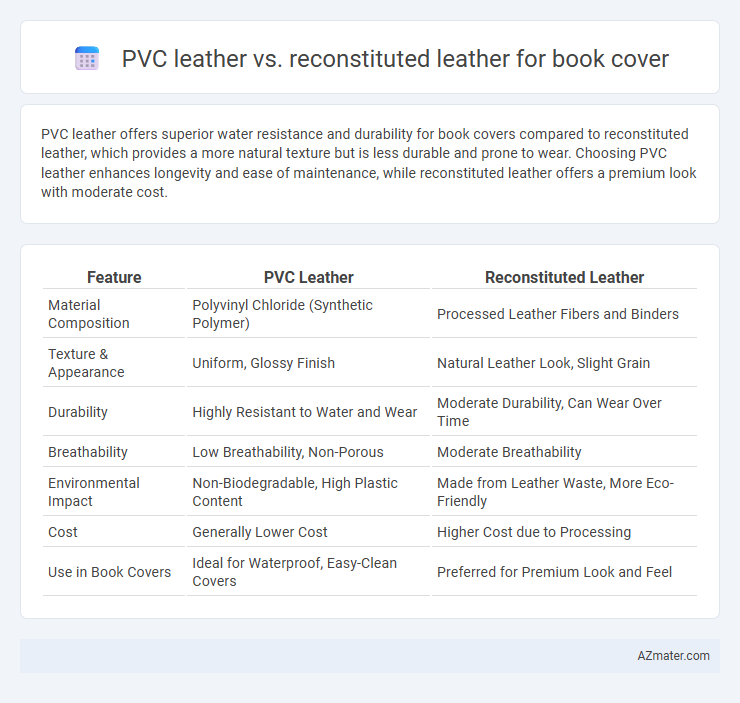PVC leather offers superior water resistance and durability for book covers compared to reconstituted leather, which provides a more natural texture but is less durable and prone to wear. Choosing PVC leather enhances longevity and ease of maintenance, while reconstituted leather offers a premium look with moderate cost.
Table of Comparison
| Feature | PVC Leather | Reconstituted Leather |
|---|---|---|
| Material Composition | Polyvinyl Chloride (Synthetic Polymer) | Processed Leather Fibers and Binders |
| Texture & Appearance | Uniform, Glossy Finish | Natural Leather Look, Slight Grain |
| Durability | Highly Resistant to Water and Wear | Moderate Durability, Can Wear Over Time |
| Breathability | Low Breathability, Non-Porous | Moderate Breathability |
| Environmental Impact | Non-Biodegradable, High Plastic Content | Made from Leather Waste, More Eco-Friendly |
| Cost | Generally Lower Cost | Higher Cost due to Processing |
| Use in Book Covers | Ideal for Waterproof, Easy-Clean Covers | Preferred for Premium Look and Feel |
Introduction to Book Cover Materials
PVC leather offers durability and water resistance, making it a popular choice for book covers that require long-lasting protection and easy maintenance. Reconstituted leather, made from shredded leather fibers bonded with polyurethane, provides a more sustainable and cost-effective alternative with a genuine leather texture. Both materials enhance book aesthetics, but PVC leather excels in weather resistance, while reconstituted leather delivers a closer tactile experience to authentic leather.
What is PVC Leather?
PVC leather, also known as polyvinyl chloride leather, is a synthetic material made by coating a fabric base with a plastic polymer, creating a durable and water-resistant surface ideal for book covers. It offers a consistent texture and color, mimicking genuine leather while providing superior resistance to wear, scratches, and fading. In contrast to reconstituted leather, PVC leather is easier to maintain and offers greater flexibility in design and customization for protective and aesthetically pleasing book covers.
What is Reconstituted Leather?
Reconstituted leather, also known as bonded leather, is made by combining shredded genuine leather fibers with a polyurethane or latex binder, resulting in a durable and cost-effective material ideal for book covers. Compared to PVC leather, reconstituted leather offers a more authentic leather texture and appearance while maintaining environmental benefits through recycling actual leather scraps. This material provides a balance of aesthetic appeal and sustainability, making it a preferred choice for high-quality bookbinding.
Key Differences: Composition & Manufacturing
PVC leather for book covers is made from polyvinyl chloride coated on a fabric base, offering durability and water resistance through a synthetic plastic composition. Reconstituted leather consists of leather scraps and fibers bonded with adhesives and resins, providing an eco-friendly alternative that mimics genuine leather texture but with less uniformity in grain. The manufacturing of PVC leather involves extrusion and lamination processes, whereas reconstituted leather is produced by compressing and bonding leather residues into sheets, impacting the cost and tactile feel of the final book cover.
Durability: PVC vs. Reconstituted Leather
PVC leather offers superior durability for book covers, resisting scratches, moisture, and wear far better than reconstituted leather, which tends to degrade and peel over time. The synthetic composition of PVC makes it more resistant to environmental factors, maintaining its appearance and structural integrity through repeated handling. Reconstituted leather, made from bonded leather fibers, lacks the robustness of PVC and often exhibits faster deterioration under frequent use.
Aesthetics and Texture Comparison
PVC leather offers a smooth, consistent texture with a glossy finish that mimics genuine leather, making book covers visually striking and easy to clean. Reconstituted leather, created from shredded leather fibers bonded with adhesives, provides a more natural, grainy texture that enhances the tactile feel but may lack the uniformity and durability of PVC. The choice between PVC and reconstituted leather hinges on whether the priority is a sleek, polished look or a richer, authentic leather sensation for book covers.
Environmental Impact & Sustainability
PVC leather, commonly used for book covers, poses significant environmental challenges due to its non-biodegradable nature and the release of toxic chemicals during production and disposal. Reconstituted leather, made from leather scraps bonded with natural or synthetic binders, offers a more sustainable alternative by reducing waste and utilizing byproducts, though it may still include synthetic components that affect biodegradability. Choosing reconstituted leather can decrease environmental impact through better resource efficiency and lower pollution compared to PVC leather, aligning with eco-friendly and sustainable book cover solutions.
Cost Factors and Affordability
PVC leather offers a more affordable option for book covers due to its lower production costs and synthetic material base, making it suitable for budget-conscious projects. Reconstituted leather, created by bonding leather scraps with adhesives, generally has higher manufacturing expenses that increase the overall price. Cost factors for PVC leather include mass production efficiency and durability, while reconstituted leather involves additional processing, often translating to less affordability in bulk orders or large-scale bookbinding.
Suitability for Book Covers
PVC leather offers high durability, water resistance, and ease of cleaning, making it ideal for book covers that require long-lasting protection and frequent handling. Reconstituted leather provides a more authentic leather texture and appearance but is less durable and prone to wear, which may reduce its suitability for heavy-use book covers. For optimal book cover performance, PVC leather is preferred in environments demanding resilience, while reconstituted leather suits decorative or light-use applications.
Conclusion: Which is Better for Your Book Cover?
PVC leather offers superior durability, water resistance, and cost-effectiveness, making it ideal for protecting book covers against daily wear and tear. Reconstituted leather provides a more authentic texture and eco-friendly appeal but tends to be less durable and may degrade faster with heavy use. Choosing PVC leather ensures long-lasting protection, while reconstituted leather suits those prioritizing aesthetics and sustainability.

Infographic: PVC leather vs Reconstituted leather for Book cover
 azmater.com
azmater.com